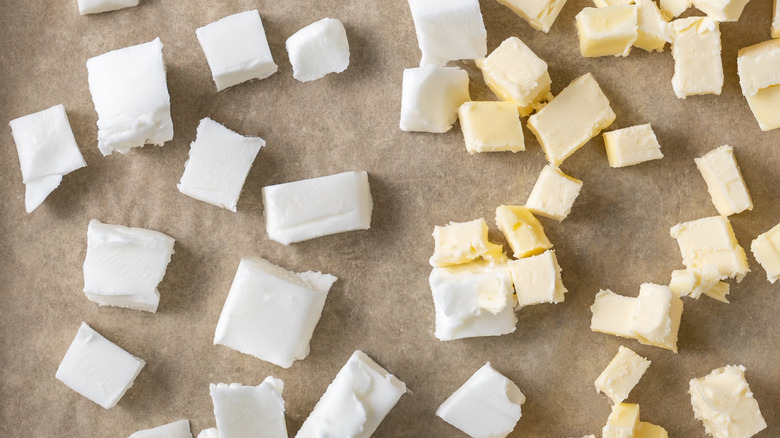What Shortening Actually Does To Your Frosting
A cake without frosting is just plain wrong. Sweet and sugary, it's the only acceptable topping for cakes and cupcakes, but it also works as a dip for homemade dunkaroos. So while you might be familiar with typical butter and sugar recipes, you can also include shortening. Unconventional, maybe, but the ingredient can actually do some pretty amazing things to your frosting.
Often used interchangeably, frosting and icing aren't the same. According to MasterClass, frosting tends to be a bit thicker and fluffier as it's made by whipping fat with sugar rather than thinner icing made by combining sugar with liquid. However, besides the striking visual impact, Dr. Oetker notes that frosting adds sweet flavor and velvety texture and can even be practical if other decorations are added to a cake.
Although butter tends to be the fat of choice when it comes to crafting cloud-like frosting, it's not the only option. Margarine or cream can work, but shortening really takes frosting to the next level. A full-fat ingredient, Healthline explains that most shortening is made from vegetable oil rather than animal fat and undergoes a process known as hydrogenation. Shortening continues to be part of the baker's arsenal despite being highly processed, but why?
It adds stability
When it comes to frosting, it's best to lean into the topping's richness. That means using full-fat ingredients like shortening to your advantage. Although butter has a creamy, sweet taste, it still contains some moisture, making it susceptible to melting — cue, shortening.
Shortening may be void of flavor, but Wilton explains that it does extraordinary things in terms of texture. Since the fatty ingredient is super sturdy, it's less likely to spread and droop off your cakes. This is a particularly useful hack to know if you're baking in warmer climates or if your cakes will be left at room temperature for an extended period.
If you're unsure how to incorporate shortening into your frosting recipe, Taste of Home recommends using a combination of shortening and butter in a 1:1 ratio. Doing this will create the perfect balance of structure and flavor. Of course, always remember to think twice before picking up the piping bag — let cakes cool completely before decorating with your magical, melt-free frosting!

